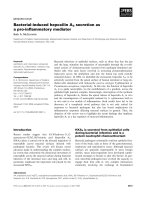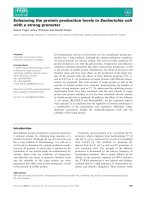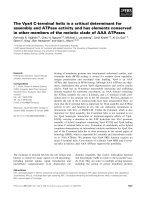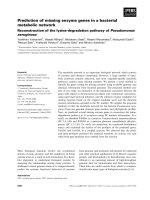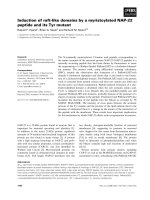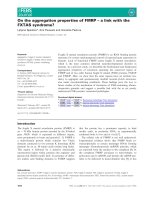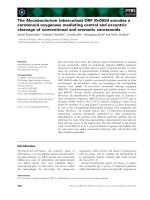báo cáo khoa học: "Lenalidomide induced good clinical response in a patient with multiple relapsed and refractory Hodgkin''''s lymphoma" pptx
Bạn đang xem bản rút gọn của tài liệu. Xem và tải ngay bản đầy đủ của tài liệu tại đây (707.46 KB, 3 trang )
JOURNAL OF HEMATOLOGY
& ONCOLOGY
Mandac and Kolonic Journal of Hematology & Oncology 2010, 3:20
/>Open Access
LETTER TO THE EDITOR
© 2010 Mandac and Kolonic; licensee BioMed Central Ltd. This is an Open Access article distributed under the terms of the Creative
Commons Attribution License ( which permits unrestricted use, distribution, and repro-
duction in any medium, provided the original work is properly cited.
Letter to the Editor
Lenalidomide induced good clinical response in a
patient with multiple relapsed and refractory
Hodgkin's lymphoma
Inga Mandac and Slobodanka Ostojic Kolonic*
Abstract
Background: A 24-year-old female patient was diagnosed with classic Hodgkin's lymphoma in clinical stage II, and
combination chemotherapy followed by radiotherapy was initiated. During the following 5 years, the disease
progressed despite several standard therapeutic approaches, including autologous and allogeneic stem cell
transplantation.
Methods: Lenalidomide (25 mg daily) treatment was then initiated in a continuous dosing schedule. Positron emission
tomography scans were performed before and during lenalidomide treatment. Hematologic and laboratory values, as
well as physical condition were also assessed before and during lenalidomide treatment.
Results: Four months after continuous lenalidomide treatment, tumor load was significantly reduced, B symptoms had
resolved, and the patient's physical condition had improved, allowing her to resume normal daily-living activities.
Evaluations after 15 months of lenalidomide treatment indicated limited disease progression. Nevertheless, the patient
was feeling well and maintaining a normal active life. Treatment was well tolerated, allowing the patient to remain on
continuous dosing, which has now been maintained for 18 months.
Conclusion: Daily, long-term lenalidomide treatment provided clinical benefit and was well tolerated in a patient with
relapsed, advanced classic Hodgkin's lymphoma.
To the editor
In February 2003, a 24-year-old female was diagnosed
with classic Hodgkin's lymphoma in clinical stage II. Her
initial treatment consisted of 6 cycles of ABVD followed
by involved-field radiotherapy of the mediastinal mass,
and resulted in complete remission until November 2004,
when she suffered a relapse. After a peripheral blood
stem cell harvest, she underwent high-dose BEAM che-
motherapy and an autologous peripheral blood stem cell
transplantation (SCT), which was completed in January
2005 and resulted in complete clinical remission. In
October 2005 a second relapse occurred, characterized
by infiltration of the malignancy into lymph nodes in the
L1 region and pelvis. The patient was treated with radio-
therapy to the pelvis and 3 cycles of standard dose BEA-
COPP resulting in partial remission lasting until
September 2006. In October 2006 a donor was identified
and an allogeneic SCT was performed resulting in a com-
plete response until February 2008 when positron emis-
sion tomography (PET) and multislice spiral computed
tomography scans identified relapse (Figure 1A). Chemo-
therapy with one cycle of LVPP did not produce a clinical
response, so in April and May 2008 the patient under-
went two cycles of gemcitabine: 1,000 mg/m
2
on day 1
and day 8. A minor clinical response was observed but
the patient's physical condition continued to worsen.
Abdominal ultrasound revealed enlarged para-aortal,
paracaval, mesenterial, and portal lymph nodes.
On June 25, 2008 treatment with continuous daily sin-
gle-agent lenalidomide (25 mg) was initiated, outside of a
clinical trial setting and based on discussions at the 10th
International Conference on Malignant Lymphoma,
Lugano, Switzerland, 2008. Prior to treatment initiation,
the patient's hematologic and laboratory values were
within or close to the normal range (Table 1). By October
* Correspondence:
1
Department of Internal Medicine, Merkur University Hospital, Zagreb, Croatia
Full list of author information is available at the end of the article
Mandac and Kolonic Journal of Hematology & Oncology 2010, 3:20
/>Page 2 of 3
2008, after 4 months of continuous lenalidomide, B
symptoms had resolved, and she was able to tolerate
treatment with no evidence of either hematologic or non-
hematologic toxicity. The patient's physical condition
improved and she was able to resume normal daily activi-
ties, such as her university studies. A PET scan per-
formed 4 months after continuous lenalidomide (Figure
1B), revealed infiltrates in the middle lung lobe and in the
right lobe, and the portal lymph node had shrunk. Meta-
bolic activity was detected in the lungs and abdominal
lymph nodes. The patient has remained on continuous
lenalidomide since 2008. In a follow-up examination in
August 2009 she was found to be in good physical condi-
tion and although her laboratory results showed mild leu-
copenia (World Health Organization hematologic
toxicity scale grade 2), no dose reduction was required
(Table 1). However, a third PET scan in September 2009
revealed new lesions in the lung, lymph nodes, and
spleen, indicating disease progression (Figure 1C). Meta-
bolic activity was detected in the lungs, left axillary
lymph nodes, spleen, and vertebral column. Despite evi-
dence of disease progression, the patient feels well, enjoys
a good quality of life, is maintaining her university stud-
ies, and was able to go on vacation. She remains on con-
tinuous lenalidomide and her disease progression is
expected to remain limited in the immediate future.
Conclusions
The lenalidomide dose selected for this patient was based
on the standard dose used in multiple myeloma, non-
Hodgkin's lymphoma, and classic Hodgkin's lymphoma
(25 mg daily for 21 days of every 28-day cycle) [1-4]. In
this patient, no significant hematologic toxicity was
detected with continuous lenalidomide, which has been
ongoing for 18 months. The observed efficacy is consis-
tent with data reported from two small studies [3,4]. Fur-
ther clinical studies are needed to assess the clinical
Table 1: Results of laboratory tests before initiation of lenalidomide treatment and after 12 months of continuous
treatment.
Laboratory value Reference
range
Values before
lenalidomide treatment
Values after 12 months of
lenalidomide (25 mg/day) treatment
White cell count (× 10
9
/L) 3.4-9.7 4.31 2.2
Red cell count (× 10
12
/L) 3.86-5.08 4.52 3.9
Hemoglobin (g/L) 119-157 119 111
Hematocrit (L/L) 0.356-0.470 0.377 0.34
Platelet count (× 10
9
/L) 158-424 196 158
Mean corpuscular volume (fL) 83.0-97.2 83.4 83
Erythrocyte sedimentation rate (mm/3.6 ks) 4-24 26 26
Total protein (g/L) 66-81 70.5 67.2
C-reactive protein (mg/L) < 5 12.1 Not done
Lactate dehydrogenase (U/L) < 241 250 175
Aspartate aminotransferase (U/L) 8-30 20 16
Alanine aminotransferase (U/L) 10-36 6 16
Gamma-glutamyl transpeptidase (U/L) 9-35 15 10
Alkaline phosphatase (U/L) 54-119 147 124
Urea (mmol/L) 2.8-8.3 4.5 3.1 (blood urea)
Creatinine (qmol/L) 63-107 58 66
Figure 1 Positron emission tomography scans. (A) Before treat-
ment with lenalidomide; (B) after 4 months of continuous lenalido-
mide treatment; and (C) after 15 months of continuous lenalidomide
treatment.
Mandac and Kolonic Journal of Hematology & Oncology 2010, 3:20
/>Page 3 of 3
utility of lenalidomide in this indication, and to inform
prescribing decisions on the most appropriate dose regi-
men.
Author Details
Department of Internal Medicine, Merkur University Hospital, Zagreb, Croatia
References
1. Wiernik PH, Lossos IS, Tuscano JM, Justice G, Vose JM, Cole CE, Lam W,
McBride K, Wride K, Pietronigro D, Takeshita K, Ervin-Haynes A, Zeldis JB,
Habermann TM: Lenalidomide monotherapy in relapsed or refractory
aggressive non-Hodgkin's lymphoma. J Clin Oncol 2008, 26:4952-4957.
2. Witzig TE, Wiernik PH, Moore T, Reeder C, Cole C, Justice G, Kaplan H,
Voralia M, Pietronigro D, Takeshita K, Ervin-Haynes A, Zeldis JB, Vose JM:
Lenalidomide oral monotherapy produces durable responses in
relapsed or refractory indolent non-Hodgkin's lymphoma. J Clin Oncol
2009, 27:5404-5409.
3. Fehniger TA, Larson S, Trinkhaus K, Siegel MJ, Cashen AF, Blum KA, Fenske
TS, Hurd DD, Goy A, DiPersio JF, Bartlett NL: A phase II multicenter study
of lenalidomide in relapsed or refractory classical Hodgkin lymphoma
[abstract]. [ />Paper18377.html].
4. Böll B, Borchmann P, Topp MS, Hänel M, Reiners KS, Engert A, Naumann R:
Lenalidomide in patients with refractory or multiple relapsed Hodgkin
lymphoma. Br J Haematol 2010, 148:480-482.
doi: 10.1186/1756-8722-3-20
Cite this article as: Mandac and Kolonic, Lenalidomide induced good clini-
cal response in a patient with multiple relapsed and refractory Hodgkin's
lymphoma Journal of Hematology & Oncology 2010, 3:20
Received: 29 April 2010 Accepted: 28 May 2010
Published: 28 May 2010
This article is available from : oonline.org/c ontent/3/1/20© 2010 Mand ac and Kolonic; li censee BioMed Ce ntral Ltd. This is an Open Access article distributed under the terms of the Creative Commons Attribution License ( ), which permits unrestricted use, distribution, and reproduction in any medium, provided the original work is properly cited.Journal of Hematology & Oncology 2010, 3:20

